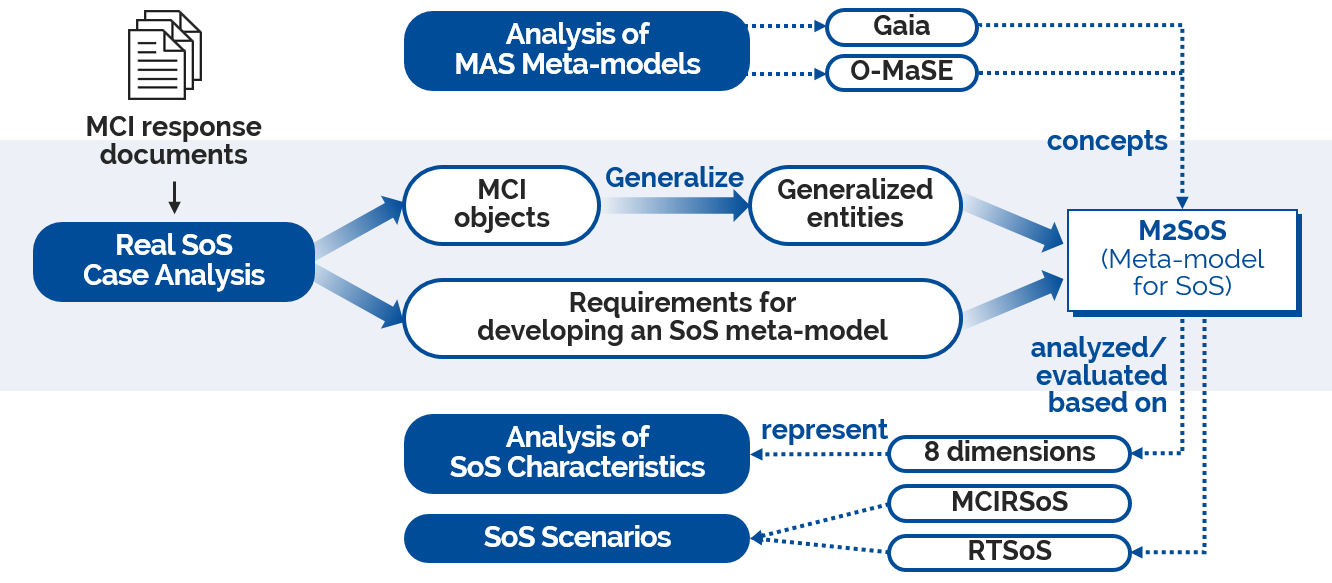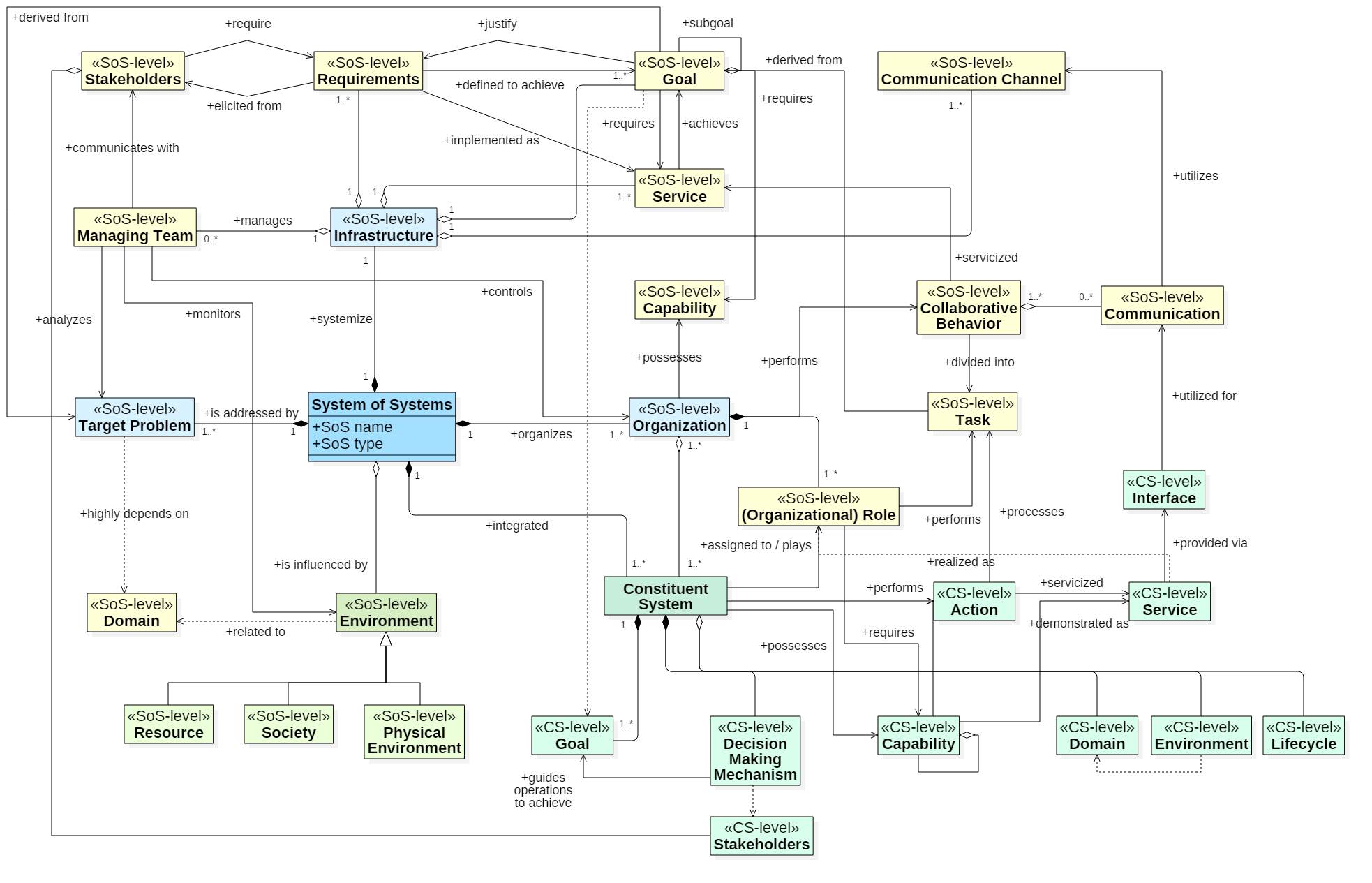Background
To address scale and complexity issues of an SoS, model-based approaches are essentially required as fundamental engineering activities for SoS analysis, design, and V&V phases. As an essential step for this purpose, we focus on developing a meta-model, called M2SoS (Meta-model for SoS), that can provide a holistic view of an SoS. To identify and define components comprising an SoS, we conducted an investigation of a real SoS case scenario, and identified objects were generalized into SoS-based terms and concepts. By using M2SoS, SoS engineers can be guided for their analysis and modeling activities, and they can also inspect completeness or correctness of their models considering SoS-specific characteristics. Also, another capability of M2SoS is to represent SoS ontologies for various SoS domains at the highest-level, and this enables SoS stakeholders (both SoS-level stakeholders and CS-level stakeholders) to establish a common knowledge base of their target SoS. If the ontology generated based on M2SoS is stored in a repository, vocabularies defined in M2SoS could be accessed and utilized for various purposes (for communications, maintenance, evolutionary development, etc.).
Overall Approach
In this study, we develop M2SoS in the following order. First, we selected a mass casualty incident (MCI) response system as a real SoS case system—we call this system MCIRSoS, and relevant documents and papers are collected for review. We analyzed the documents to identify objects comprising of MCIRSoSs and their operations, and parsed objects were generalized to represent SoS-oriented entities. At the same time, we defined several requirements for developing an SoS meta-model based on the investigation. Although we aim at developing a general meta-model for SoSs, there are too many SoSs for us to investigate. Our approach is first to focus on SoSs of a specific domain, and to propose a meta-model and then analyze it with general SoS characteristics.
To develop M2SoS, we first take a look into some meta-model approaches for multi-agent systems (MAS). Since an MAS and SoS have a number of similarities, we reviewed meta-models for MAS to come up with basic ideas and concepts from them as follows.
Table: Meta-modeling approaches of Multi-agent Systems (MAS)
| Meta-model | Major component entities |
| Gaia | Organization, Organization Rule, Organizational Structure, Organizational Pattern, Role, Protocol, Activity, Responsibility, Permission, Safety/Liveness Property |
| O-MaSE | Actor, Organization, Agent, Role, Goal, Capability, Policy, Environment Object Type, Environment Property, Domain Model, Protocol, Message, Plan, Action |
In order to develop a meta-model for SoS representation, we investigated several literatures related to Mass Casualty Incident (MCI) response systems which are real cases of SoSs. Through the investigation, we identify a number of objects comprising the response systems, and they are generalized into SoS-specific terms for developing a meta-model. Detailed scenario specification is uploaded on [Link].
After investigating MCI response documents, we could determine some characteristics that should be considered to build a meta-model for SoS representations. To do that we specify four major requirements that M2SoS should consider and fulfill as follows.
- Requirement 1: Distinguishing SoS-level entities and CS-level entities
- Requirement 2: Defining SoS-level goals, requirements, services, behaviors and relationships among these entities
- Requirement 3: Defining SoS-level environmental factors
- Requirement 4: Developing a meta-model for representing SoS ontologies
Based on our investigation and requirements, we develop M2SoS by following several steps.
- Step 1. Definition of primary components of an SoS
- Step 2. Definition of SoS-level and Organization-level entities
- Step 3. Definition of CS-level entities
- Step 4. Definition of SoS-level environment entities
Detailed description about requirements and steps is included in our paper (See related publications).
Results
Figure: Simplified version of M2SoS (Meta-model for SoS)
Related Publications
- Young-Min Baek, Jiyoung Song, Yong-Jun Shin, Sumin Park, Doo-Hwan Bae, “A Meta-Model for Representing System-of-Systems Ontologies”, 6th International Workshop on Software Engineering for Systems-of-Systems (SESoS), 2018.
- Young-Min Baek, Sumin Park, Yong-Jun Shin, and Doo-Hwan Bae, “Development of Ontology-based System-of-Systems Meta-model Based on the Analysis of SoS Case Scenario”, Proceedings of the 20th Korea Conference on Software Engineering [KCSE 2018], No. 20, Issue. 1, pp.3-4, 2018.
- Yong-Jun Shin, Sumin Park, Young-Min Baek, and Doo-Hwan Bae, “Scenario-based Analysis of System-of-Systems Meta-model and Applicability Analysis for Statistical Verification”, Proceedings of the 20th Korea Conference on Software Engineering [KCSE 2018], No 20. Issue 1, pp.31-40, 2018.
- Young-Min Baek, Sumin Park, Yong-Jun Shin, and Doo-Hwan Bae,, “Development of Ontology-based System-of-Systems Meta-model Based on the Analysis of SoS Case Scenario,” KIISE Journal (Software and Application), 2018.
Related Tools


